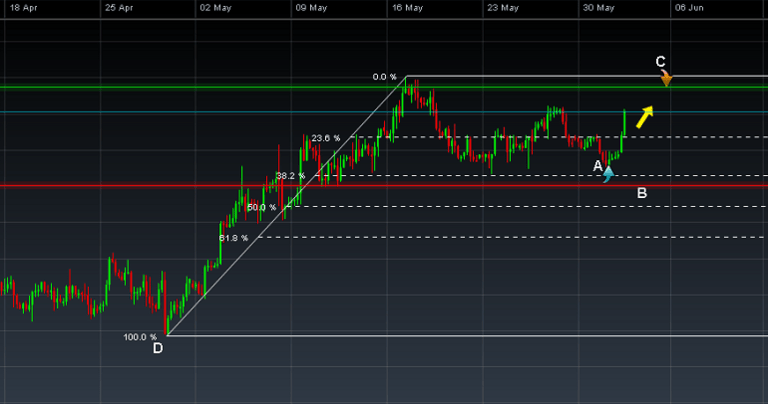We've summarised five swing trade strategies below that you can use to identify trading opportunities and manage your trades from start to finish. Apply these swing trading techniques to the stocks you're most interested in to look for possible trade entry points. You can also use tools such as CMC Markets' pattern recognition scanner to help you identify stocks that are showing potential technical trading signals.
Fibonacci retracement
The Fibonacci retracement pattern can be used to help traders identify support and resistance levels, and therefore possible reversal levels on stock charts. Stocks often tend to retrace a certain percentage within a trend before reversing again, and plotting horizontal lines at the classic Fibonacci ratios of 23.6%, 38.2% and 61.8% on a stock chart can reveal potential reversal levels. Traders often look at the 50% level as well, even though it does not fit the Fibonacci pattern, because stocks tend to reverse after retracing half of the previous move.
A stock swing trader could enter a short-term sell position if price in a downtrend retraces to and bounces off the 61.8% retracement level (acting as a resistance level), with the aim to exit the sell position for a profit when price drops down to and bounces off the 23.6% Fibonacci line (acting as a support level).
Support and resistance triggers
Support and resistance lines represent the cornerstone of technical analysis and you can build a successful stock swing trading strategy around them.
A support level indicates a price level or area on the chart below the current market price where buying is strong enough to overcome selling pressure. As a result, a decline in price is halted and price turns back up again. A stock swing trader would look to enter a buy trade on the bounce off the support line, placing a stop loss below the support line.
Resistance is the opposite of support. It represents a price level or area above the current market price where selling pressure may overcome buying pressure, causing the price to turn back down against an uptrend. In this case a swing trader could enter a sell position on the bounce off the resistance level, placing a stop loss above the resistance line. A key thing to remember when it comes to incorporating support and resistance into your swing trading system is that when price breaches a support or resistance level, they switch roles – what was once a support becomes a resistance, and vice versa.
Channel trading
This swing trading strategy requires that you identify a stock that's displaying a strong trend and is trading within a channel. If you have plotted a channel around a bearish trend on a stock chart, you would consider opening a sell position when the price bounces down off the top line of the channel. When using channels to swing-trade stocks it's important to trade with the trend, so in this example where price is in a downtrend, you would only look for sell positions – unless price breaks out of the channel, moving higher and indicating a reversal and the beginning of an uptrend.
10- and 20-day SMA
Another of the most popular swing trading techniques involves the use of simple moving averages (SMAs). SMAs smooth out price data by calculating a constantly updating average price which can be taken over a range of specific time periods, or lengths. For example, a 10-day SMA adds up the daily closing prices for the last 10 days and divides by 10 to calculate a new average each day. Each average is connected to the next to create a smooth line which helps to cut out the 'noise' on a stock chart. The length used (10 in this case) can be applied to any chart interval, from one minute to weekly. SMAs with short lengths react more quickly to price changes than those with longer timeframes.
With the 10- and 20-day SMA swing trading system you apply two SMAs of these lengths to your stock chart. When the shorter SMA (10) crosses above the longer SMA (20) a buy signal is generated as this indicates that an uptrend is underway. When the shorter SMA crosses below the longer-term SMA, a sell signal is generated as this type of SMA crossover indicates a downtrend.
MACD crossover
The MACD crossover swing trading system provides a simple way to identify opportunities to swing-trade stocks. It's one of the most popular swing trading indicators used to determine trend direction and reversals. The MACD consists of two moving averages – the MACD line and signal line – and buy and sell signals are generated when these two lines cross. If the MACD line crosses above the signal line a bullish trend is indicated and you would consider entering a buy trade. If the MACD line crosses below the signal line a bearish trend is likely, suggesting a sell trade. A stock swing trader would then wait for the two lines to cross again, creating a signal for a trade in the opposite direction, before they exit the trade.
The MACD oscillates around a zero line and trade signals are also generated when the MACD crosses above the zero line (buy signal) or below it (sell signal).

